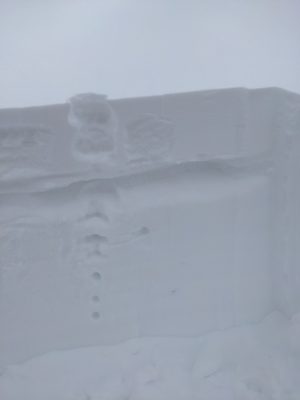Basic Information
Observation Details
Observation Date:
February 24, 2022Submitted:
February 25, 2022Observer:
SAC - VandenBos, Coba (both off duty)Zone or Region:
Banner SummitLocation:
Banner (6,500-9,100')Signs of Unstable Snow
Recent Avalanches?
None ObservedCracking?
IsolatedCollapsing?
None ExperiencedSnow Stability
Stability Rating:
Very GoodConfidence in Rating:
ModerateStability Trend:
Advanced Information
Weather Summary
Wind:
CalmNew/Recent Snowfall:
1-2cm at highway, 3-5cm at upper elevationsLargely calm winds with occasional periods of light wind out of the N/NW. Snowing S-1 to S1 throughout the day, accumulating 3-5cm at upper elevations. Cold all day.
Avalanche Observations
No recent avalanches observed.
Snowpack Observations
There are 15-18cm of low-density new snow on top of the 2/14 (V-day) crust at upper elevations. It would not take a ton of wind to get this snow moving and to see a bump in danger/decrease in stability. We've been lucking out so far, but the fun might end on Saturday night/Sunday morning... I toured in this same area on 2/22 and found that most of my tracks were still plainly visible. In a few places at upper elevations, the wind had moved enough snow to cover my skin tracks. In these same areas, there were some 10-15cm thick 4F slabs. These slabs were limited in areal extent (1-2 dinner table sized) but were sensitive to my weight and cracked easily. Had these been significantly thicker or larger I would not have been comfortable managing them in the terrain I was finding them in.
We have a few budding persistent slab problems in this zone: accumulating snowfall from storms on 1/20, 1/24, 1/30, 2/14 and the past week are gradually building a slab (now ~30cm thick) on top of the weak, faceted snow that developed in the January drought here. Much of this storm snow faceted before being subsequently buried. This weak snow is best developed on shaded slopes at lower and middle elevations. Below this snow, a stout 1F to P slab makes up the base of the snowpack. We did not dig down to 12/11. At upper elevations, multiple N/NW wind events in February cleaned back some of the upper pack facet stack and left a variety of wind-packed and scoured surfaces, which I'd expect to be slightly friendlier, but still suspect. It is hard to differentiate the different late Jan/early Feb storm snow in pits, with the exception of the V-day crust, which makes for a great marker. As noted during formation, this crust exists on all aspects up to at least 8,000', thanks to warm overnight temperatures and intense ambient shortwave and longwave radiation on 2/9.
On SE-E-SW-WSW slopes a very stout crust (2/14) exists on all steep slopes. There are some small facets both above and below this crust. On solar margins this crust thins and is not supportable.
Both the upper pack facet stack and the 2/14 crust on solars could present longer lasting persistent problems once enough of a snow develops on top of them. We've got some snow in the 7-10 days forecast, we will see what happens if it actually decides to come our way. If it does, I'll be taking a big step back, it will be easy to be lulled into a sense of complacency after the month-long streak of LOW danger...

Avalanche Problems
We did not encounter any avalanche problems, but we were conscious of wind transported snow and potential for sluffing on steep slopes.
